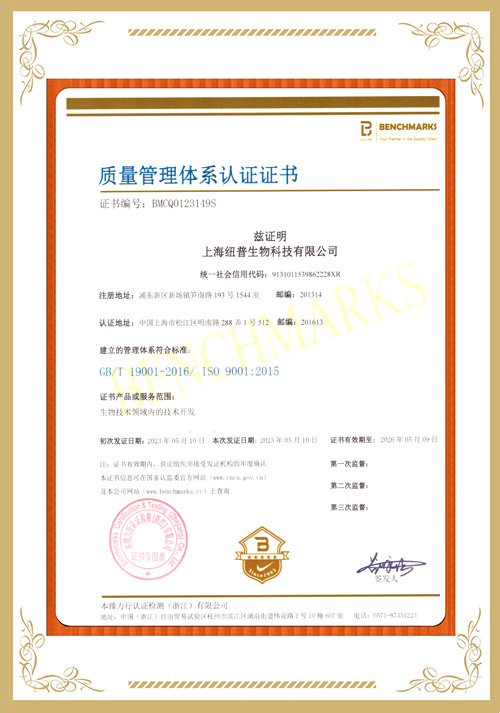- 抗体类型:多克隆
- 抗体来源:兔
- 抗体应用:ELISA, WB, IHC, IF
- 特异性:Human, Mouse, Rat; other species not tested.
产品详情
-
产品名称
GADD34 antibody
-
抗体类型
多克隆
-
抗体来源
兔
-
抗体亚型
兔IgG
-
抗体描述
GADD34 Rabbit Polyclonal antibody. Positive WB detected in K-562 cells, HeLa cells, HepG2 cells, Jurkat cells. Positive IHC detected in human pancreas cancer tissue, human colon cancer tissue. Positive IF detected in PC-3 cells. Observed molecular weight by Western-blot: 100 kDa
-
抗体应用
ELISA, WB, IHC, IF
-
应用推荐
Recommended Dilution:
WB: 1:200-1:2000
IHC: 1:20-1:200
IF: 1:20-1:200
-
特异性
Human, Mouse, Rat; other species not tested.
-
蛋白别名
GADD34, growth arrest and DNA damage-inducible protein 34, PPP1R15A
-
制备方法
This antibody was obtained by immunization of GADD34 recombinant protein (Accession Number: NM_014330). Purification method: Antigen affinity purified.
-
组分
PBS with 0.1% sodium azide and 50% glycerol pH 7.3.
-
储存方法
Store at -20℃. DO NOT ALIQUOT
-
背景介绍
GADD34, also named PPP1R15A, belongs to the PPP1R15 family. GADD34 can be triggered as a direct target of activating transcription factor4 (ATF4) under ER stress, it plays a pivotal role in the recovery of cells from shut-down of translation induced by ER stress. It recruits the serine/threonine-protein phosphatase (PP1) to dephosphorylate the translation initiation factor eIF2alpha, thereby reversing the shut-off of protein synthesis initiated by stress-inducible kinases and facilitating recovery of cells from stress. GADD34 down-regulates the TGF-beta signaling pathway by promoting dephosphorylation of TGFB1 via PP1. It may also promote apoptosis by inducing TP53 phosphorylation on 'Ser-15'. Starvation-induced expression of GADD34 reduced mTOR activity and induced autophagy in wild-type mice, but not in GADD34 KO mice. Molecular weight of GADD34 appears to be about 100 kDa which was confirmed in GADD34 KO mice and drug treated cells, despite the predicated MW of 73 kDa, and Proteintech's GADD34 antibody 10449-1-AP primarily recongize the 100 kDa band.
-
参考文献
- Nagelkerke A, Bussink J, van der Kogel AJ, Sweep FC, Span PN. The PERK/ATF4/LAMP3-arm of the unfolded protein response affects radioresistance by interfering with the DNA damage response. Radiotherapy and oncology : journal of the European Society for Therapeutic Radiology and Oncology. 108(3):415-21. 2013.
- Wu H, Wei L, Fan F. Integration of Hippo signalling and the unfolded protein response to restrain liver overgrowth and tumorigenesis. Nature communications. 6:6239. 2015.
- Chambers JE, Dalton LE, Clarke HJ. Actin dynamics tune the integrated stress response by regulating eukaryotic initiation factor 2α dephosphorylation. eLife. 4:. 2015.
- van 't Wout EF, van Schadewijk A, van Boxtel R. Virulence Factors of Pseudomonas aeruginosa Induce Both the Unfolded Protein and Integrated Stress Responses in Airway Epithelial Cells. PLoS pathogens. 11(6):e1004946. 2015.
- Loveless TB, Topacio BR, Vashisht AA. DNA Damage Regulates Translation through β-TRCP Targeting of CReP. PLoS genetics. 11(6):e1005292. 2015.
- Tsaytler P, Harding HP, Ron D, Bertolotti A. Selective inhibition of a regulatory subunit of protein phosphatase 1 restores proteostasis. Science (New York, N.Y.). 332(6025):91-4. 2011.
- Radford H, Moreno JA, Verity N, Halliday M, Mallucci GR. PERK inhibition prevents tau-mediated neurodegeneration in a mouse model of frontotemporal dementia. Acta neuropathologica. 130(5):633-42. 2015.
- Young SK, Willy JA, Wu C, Sachs MS, Wek RC. Ribosome Reinitiation Directs Gene-specific Translation and Regulates the Integrated Stress Response. The Journal of biological chemistry. 290(47):28257-71. 2015.


